 Global| Dec 20 2011
Global| Dec 20 2011EMU Shows Withering Trade Trends
Summary
The shorter term or ‘sequential’ trade trends are not so clear but the graph shows a clear trend in EMU exports and imports. Exports and imports have been losing broadly after seeing growth rates peak in early 2010. The deficit [...]
 The shorter term or ‘sequential’ trade trends are not so clear but the graph shows a clear trend in EMU exports and
imports. Exports and imports have been losing broadly after seeing growth rates peak in early 2010. The deficit pattern
is a picture of erratically steady deficits punctuated by a few movements into surplus that then descended
back into a mire of deficits.
The shorter term or ‘sequential’ trade trends are not so clear but the graph shows a clear trend in EMU exports and
imports. Exports and imports have been losing broadly after seeing growth rates peak in early 2010. The deficit pattern
is a picture of erratically steady deficits punctuated by a few movements into surplus that then descended
back into a mire of deficits.
The pattern of trade is showing a two month episode of surplus and a recent trend that has edged toward smaller deficits. This shift might be a move that will have more lasting impact as the euro-Zone has been slowing, clearly cutting import growth, and the euro currency itself has been under pressure improving competiveness in the Zone.
Export performance is harder to pin down as the yr/yr trends have exports slowing but the sequential growth rates show that MFG export growth rates have been picking up. Even so, MFG exports fell hard in Sept but they still only half as hard as did MFG imports.
The Zone remains under pressure as ECB president Mario Draghi today warned Euro-Area members against looking for outside support saying nations needed to depend on their own plans to fix their economies He also warned that the help from the ECB would not be ‘eternal.’ Draghi seemed to offer a forecast of recession when he said that an “unavoidable” short-term economic contraction in the euro area may be mitigated by a return of confidence if governments implement budget consolidation plans. That also sounds a lot like cheering for more austerity in the face of an oncoming recession...I wonder which school of thought that odd bit of economics represents. Was Mr. Draghi taught that at MIT or is he now firmly in the German school of economics? Is it now to be austerity; everywhere, all the time?
Robert Brusca
AuthorMore in Author Profile »Robert A. Brusca is Chief Economist of Fact and Opinion Economics, a consulting firm he founded in Manhattan. He has been an economist on Wall Street for over 25 years. He has visited central banking and large institutional clients in over 30 countries in his career as an economist. Mr. Brusca was a Divisional Research Chief at the Federal Reserve Bank of NY (Chief of the International Financial markets Division), a Fed Watcher at Irving Trust and Chief Economist at Nikko Securities International. He is widely quoted and appears in various media. Mr. Brusca holds an MA and Ph.D. in economics from Michigan State University and a BA in Economics from the University of Michigan. His research pursues his strong interests in non aligned policy economics as well as international economics. FAO Economics’ research targets investors to assist them in making better investment decisions in stocks, bonds and in a variety of international assets. The company does not manage money and has no conflicts in giving economic advice.






